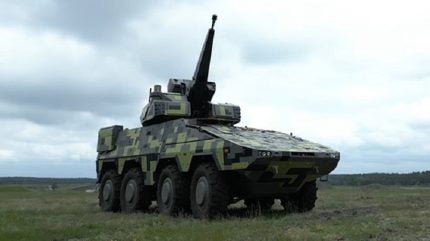
Rheinmetall will develop and deliver 16 Skyranger 30 turrets for the Danish Armed Forces. The Nordic kingdom will integrate these units onto an undisclosed 8×8 armoured vehicle type as an updated form of mobile air defence.
It is likely that this vehicle type will be the fifth-generation Piranha V – 191 of 309 units were delivered between 2018 and 2020 according to GlobalData intelligence. The Danes selected this platform, manufactured by General Dynamics European Land Systems, in 2015 as a replacement for the legacy M113 procured from as early as the 1960s.
The order is worth a figure in the low three-digit million euro range. In addition, the customer has ordered ammunition in the low double-digit million euro range.
Deliveries of the serial turrets are scheduled to arrive between 2027 and 2028, while a prototype is expected to be delivered in late 2026.
Skyranger use in Danish brigade
“The signing of this contract is an important step toward establishing the brigade’s air defence, which is an essential part of making the brigade fully operational,” commented Lieutenant General Per Pugholm Olsen, head of the Danish procurement agency, FMI.
A brigade is a tactical formation that is made up of a few battalions, with somewhere between 2,000 and 8,000 troops.
The Danish Army have two brigades: the first is an operational brigade that is transitioning toward a standard Nato medium-sized brigade, while the second is non-operational and responsible for training and developing the Army’s reconnaissance, tank and light infantry formations.
In 2020, it was anticipated that a Danish brigade would deploy roughly 4,000 soldiers in an independent formation by this year.
“The selection of the Skyranger turret and its machine cannon was made in close cooperation with our colleagues at the Defence Command,” added Olsen.
Operators use Skyranger 30 at close and very close range against low-altitude aerial threats such as fixed and rotary winged aircraft, cruise missiles and now, as modern warfare evolves, uncrewed aerial systems (UAS) such as loitering munitions.
Growing European use
Skyranger 30 is a short-range air defence (SHORAD) turret system equipped with a 30-millimetre 173 KCE revolver gun, surface-to-air missiles and a sensor suite.
Austria originally placed an order for the procurement of 36 Skyranger 30 systems as the first customer; the country will integrate them onto their Pandur vehicles. Other Nato and EU member states are also planning to procure the system or have already initiated the process.
Much like Denmark, Hungary also acquired the turrets for its Lynx armoured fighting vehicles strengthening the Army’s heavy infantry brigade capability in line with their commitment to Nato.
In an effort to accommodate a range of European missiles in a new age of military demand, Rheinmetall announced in June that it would collaborate with MBDA to allow operators to fire the Enforcer missile from the SHORAD system.
Given the rapid consumption rate of munitions in the Russia-Ukraine war, these instances of industrial collaboration are essential for European armies to be able to fire whatever they have when needed, and to interoperate with allied forces.
The global remote weapon stations and turret systems market is valued at $10bn in 2024, accoridng to GlobalData, and this is projected to grow at a compound annula growth rate of 5% over the next decade.
It is expected to reach $16.2bn by 2034 and cumulatively value $143.9bn over the forecast period.


